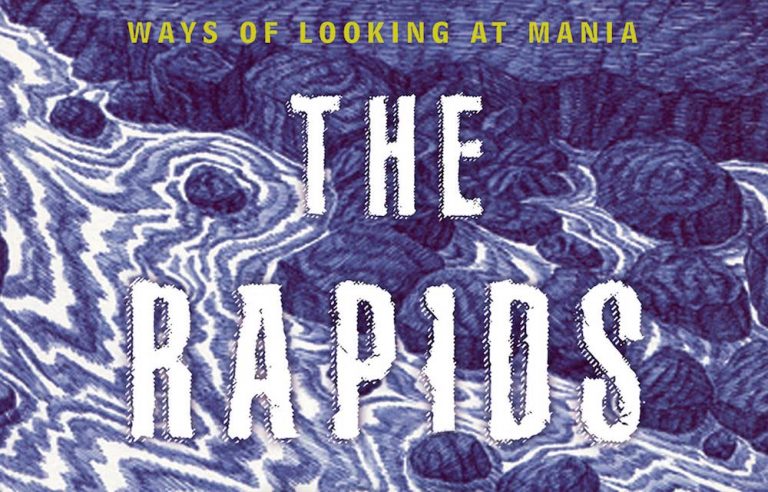When Sydney writer Sam Twyford-Moore sat down to write a book about his experiences with manic depression, as well as the condition’s representation across the arts and media, he already had the perfect name for it: The Rapids.
“It just came to me and it was immediately like, ‘That’s the title.’ It was kind of a guiding feature,” he recalls. The phrase’s double meaning – referring to the feeling of riding rapids or acting at a rapid pace – appealed to him, and it certainly fits the winding, restless structure of the book. “It’s jolty,” he agrees with a laugh.
An ambitious hybrid of memoir and cultural criticism, The Rapids is subtitled Ways Of Looking At Mania. Making the most of that open-ended brief, Twyford-Moore ties together many books on the subject while reflecting on famous cases of people who have been diagnosed as bipolar or manic depressive, including Carrie Fisher and poet Robert Lowell. He also examines possible mania in the work and personal lives of Kanye West, filmmaker Paul Thomas Anderson, and the late monologist Spalding Gray.
Often told in short, sharp paragraphs, the book unpacks the modern echo chamber and the nagging stigmas around mental illness. Twyford-Moore references several books that link mania to creativity, though he writes that’s “the least interesting aspect of the condition” to him.
“I was trying to look at this from a literary and culture critic[’s] perspective, as well as my own personal perspective, and attempt a kind of cultural history,” he explains. “But it’s more looking at how these instances of manic depression or mania in the public form a cultural identity. I hadn’t see that done [elsewhere]. Hopefully that has some sort of culturally useful function to someone who lives with the condition, or knows someone who lives with the condition.”
Twyford-Moore is well known in Australian writing circles, having previously launched the Digital Writers’ Festival and run the Emerging Writers’ Festival. He’s contributed to The Monthly and The Lifted Brow, and some of the more memoir-leaning aspects of the book appeared in earlier forms in various lit magazines. Parts of the book were written up to a decade ago, but mostly Twyford-Moore wrote it in six months, following six months of research.
It’s a fascinating read, balancing the personal and scholarly while weighing the idea of manic depression as a public affliction. It’s also defiantly idiosyncratic, with Twyford-Moore asserting himself not just as someone living with manic depression but as an articulate critic with unflinching opinions on the texts he’s consulting – whether they’re movies, songs, novels, biographies or memoirs. “My background is mostly as a critic,” he says. “I couldn’t shake that off, I guess.”
Love Music?
Get your daily dose of metal, rock, indie, pop, and everything else in between.
As for the book’s unconventional structure, which corrals an uncommon variety of approaches into broader sections like “Ways of Reading” and “Ways of Seeing”, it feels like a necessary way for the author to connect so many different threads. “I wanted to play with it a bit,” he admits. “I always had it in my head that I didn’t want it to be straightforward. I wanted to keep as much of myself out of the start of the book and save that more [for] the end. Obviously some of the chapters are more far out than others.”
Indeed, one chapter takes the form of an imaginary audio commentary for John Cassavettes’ 1974 film A Woman Under The Influence. “That was the one I was most anxious about,” says Twyford-Moore, noting that his publisher, NewSouth, specialise in straight non-fiction. But it all worked out: “They loved it. I think they were happy it was short,” he says. “They could see what I was trying to do.”
Twyford-Moore’s own biographical details come out gradually in the book, used sparingly and only when truly necessary. He describes a manic episode where he drove from Sydney to Melbourne overnight and later broke into a bed-and-breakfast, committing other crimes along the way. While he leaves the exact consequences of those actions as “an open-ended ambiguity,” he’s satisfied with the quantity of personal revelations that made it into the book.
“With writing anything, there’s stuff you can’t say,” he observes. “It’s an intensely personal disorder, and I think I gave the right amount of myself.” As for his treatment, he doesn’t go into great detail but does pointedly write that “mental health services in this country are hugely inaccessible.” Whether someone is an acute crisis mode or just living by day by day with a disorder, the high costs of medication and other treatment represent a very real barrier to recovery.
As he begins to do the publicity rounds for The Rapids, Twyford-Moore is already working on a second book, looking at Australian writers, actors and directors in America, and “how America impacts on Australian cultural production.” Again, it’s leaning towards cultural criticism with some “meta-biographical portraits,” but he thinks it’ll be “a little bit more straightforward in its construction.”
At one point in The Rapids, near the end of a section called “The Reckoning,” he states, “Writing this provides no real relief, but opens an uncomfortable enquiry that will go on for some time to come.”
But some degree of relief might yet arrive, he admits on the phone. “The next stage for me is how people react to it,” he says. “Maybe that will provide some relief. I don’t know. I hope it has some use at the end of the day.”


































